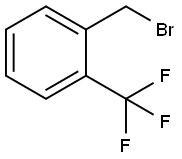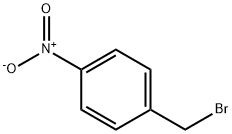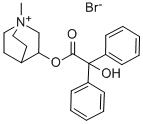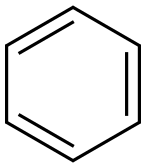2-(Trifluoromethyl)benzyl bromide
Synonym(s):α′-Bromo-α,α,α-trifluoro-o-xylene
- CAS NO.:395-44-8
- Empirical Formula: C8H6BrF3
- Molecular Weight: 239.03
- MDL number: MFCD00013558
- EINECS: 206-901-7
- SAFETY DATA SHEET (SDS)
- Update Date: 2023-12-25 13:23:17

What is 2-(Trifluoromethyl)benzyl bromide?
Chemical properties
Colorless to light yellow liqui
The Uses of 2-(Trifluoromethyl)benzyl bromide
2-(Trifluoromethyl)benzyl bromide may be used in chemical synthesis.
Preparation
A solution of 30 ml of phosphorus tribromide in 60 ml of absolute toluene was added dropwise at 20°-30° C. to a solution of 14 g of o-trifluoromethylbenzyl alcohol in 80 ml of absolute toluene. Subsequently, the reaction mixture was stirred at room temperature for 2 hours, the toluene was distilled under reduced pressure, the residue was dissolved in methylene chloride, treated with water and the mixture was adjusted to pH 8.0 with potassium hydrogen carbonate. The aqueous phase was extracted three times with CH2Cl2 and the organic phases were washed twice with water and once with saturated NaCl solution, dried over Na2 SO4 and evaporated under reduced pressure. 2-(Trifluoromethyl)benzyl bromide was obtained as the residue.
Properties of 2-(Trifluoromethyl)benzyl bromide
| Melting point: | 34-35 °C |
| Boiling point: | 72 °C (7.5 mmHg) |
| Density | 1.571 g/mL at 25 °C(lit.) |
| refractive index | 1.496-1.499 |
| Flash point: | 83 °C |
| storage temp. | under inert gas (nitrogen or Argon) at 2-8°C |
| form | powder to lump to clear liquid |
| color | White or Colorless to Light yellow |
| Specific Gravity | 1.571 |
| Sensitive | Lachrymatory |
| BRN | 2256977 |
| CAS DataBase Reference | 395-44-8(CAS DataBase Reference) |
| NIST Chemistry Reference | 2-Trifluoromethylbenzyl bromide(395-44-8) |
Safety information for 2-(Trifluoromethyl)benzyl bromide
| Signal word | Danger |
| Pictogram(s) |
 Corrosion Corrosives GHS05 |
| GHS Hazard Statements |
H314:Skin corrosion/irritation |
| Precautionary Statement Codes |
P280:Wear protective gloves/protective clothing/eye protection/face protection. P363:Wash contaminated clothing before reuse. P303+P361+P353:IF ON SKIN (or hair): Remove/Take off Immediately all contaminated clothing. Rinse SKIN with water/shower. P305+P351+P338:IF IN EYES: Rinse cautiously with water for several minutes. Remove contact lenses, if present and easy to do. Continuerinsing. P405:Store locked up. |
Computed Descriptors for 2-(Trifluoromethyl)benzyl bromide
| InChIKey | TXVVVEUSVBLDED-UHFFFAOYSA-N |
New Products
4-AMINO-TETRAHYDRO-PYRAN-4-CARBOXYLIC ACID HCL 4-(Dimethylamino)tetrahydro-2H-pyran-4-carbonitrile 4-Aminotetrahydropyran-4-carbonitrile Hydrochloride (R)-3-Aminobutanenitrile Hydrochloride 3-((Dimethylamino)methyl)-5-methylhexan-2-one oxalate 1,4-Dioxa-8-azaspiro[4.5]decane 5-Bromo-2-nitropyridine Nimesulide BP Aceclofenac IP/BP/EP Diclofenac Sodium IP/BP/EP/USP Mefenamic Acid IP/BP/EP/USP Ornidazole IP Diclofenac Potassium THOMAIND PAPER PH 2.0 TO 4.5 1 BOX BUFFER CAPSULE PH 9.2 - 10 CAP SODIUM CHLORIDE 0.1N CVS ALLOXAN MONOHYDRATE 98% PLATINUM 0.5% ON 3 MM ALUMINA PELLETS (TYPE 73) LITHIUM AAS SOLUTION 2-Bromo-1-(bromomethyl)-3-chloro-5-nitrobenzene 2-Bromo-3-nitroaniline N-(3-Hydroxypropyl)-N-methylacetamide 3-Bromo-6-chloropyridazine 4-ethyl-3-nitrobenzoic acidRelated products of tetrahydrofuran








You may like
-
 2-(Trifluoromethyl)benzyl Bromide CAS 395-44-8View Details
2-(Trifluoromethyl)benzyl Bromide CAS 395-44-8View Details
395-44-8 -
 1-Methyl-6-oxo-1,6-dihydropyridazine-3-carbonitrile 98%View Details
1-Methyl-6-oxo-1,6-dihydropyridazine-3-carbonitrile 98%View Details
99903-60-3 -
 1823368-42-8 98%View Details
1823368-42-8 98%View Details
1823368-42-8 -
 2-(3-(tert-butyl)phenoxy)-2-methylpropanoic acid 1307449-08-6 98%View Details
2-(3-(tert-butyl)phenoxy)-2-methylpropanoic acid 1307449-08-6 98%View Details
1307449-08-6 -
 Ethyl 3-(furan-2-yl)-3-hydroxypropanoate 25408-95-1 98%View Details
Ethyl 3-(furan-2-yl)-3-hydroxypropanoate 25408-95-1 98%View Details
25408-95-1 -
 2-Chloro-5-fluoro-1-methoxy-3-methylbenzene 98%View Details
2-Chloro-5-fluoro-1-methoxy-3-methylbenzene 98%View Details
1805639-70-6 -
 1784294-80-9 98%View Details
1784294-80-9 98%View Details
1784294-80-9 -
 Lithium ClavulanateView Details
Lithium ClavulanateView Details
61177-44-4